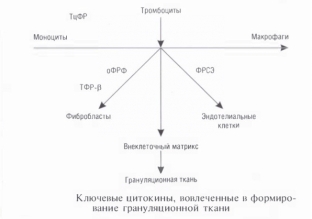Suturing – this, as it seems at first glance, is one of the simplest stages of any surgical intervention. It is with this manipulation that young doctors often begin their practice, since suturing is the final stage of the operation. But in aesthetic surgery, the process suturing a surgical wound is especially significant, since the main task of such interventions is to eliminate cosmetic defects, and the divergence of sutures or the formation of scars do not color the work of a plastic surgeon at all. In order to avoid such "troubles" it is necessary to understand how the repair of a skin wound occurs and what factors play a major role in this process.
Suturing a surgical wound: what complications do doctors fear
Surgical wound healing – This is a complex and lengthy process that accompanies the violation of the integrity of the skin. Any skin wound in an adult heals with the formation of a scar, which can be subtle in incised wounds and pronounced after the healing of large wound surfaces. Regenerative wound healing, in which the restored epidermis and dermis are as close as possible to normal architectonics, is possible only in the early stages of intrauterine development. Divergence of seams – this is another undesirable consequence of aesthetic operations, as it can lead to improper healing with the formation of a large scar, as well as complications such as infection of the wound.
Surgical wound:
- The role of cytokines in the process of surgical wound healing;
- what processes occur in a surgical wound under the influence of cytokines;
- what "techniques" help to avoid divergence of the edges of the surgical wound.
The role of cytokines in the process of surgical wound healing
Repair of a surgical wound begins immediately after damage to the integrity of the skin, and the first stage of this process is the release of blood elements, primarily platelets, from the vessels. From this moment until the formation of granulation tissue, cytokines play a crucial role in the wound healing process - peptide molecules that affect neighboring target cells. TsFR (platelet growth factor) – a cytokine that plays an important role in the development of the inflammatory response. It attracts leukocytes to the site of damage and maintains their activity. Granulocytes, the first of these leukocytes, clean the surface of the wound, then monocytes under the action of TcFR degenerate into macrophages that produce the following cytokines:
- TFR-beta – transforming growth factor "beta";
- oFRF – major fibroblast growth factor;
- FRSE – vascular endothelial growth factor.
All these cytokines, by stimulating the proliferation of fibroblasts and endothelial cells, play an important role in the formation of granulation tissue.

What processes occur in a surgical wound under the influence of cytokines
Due to cytokines, fibroblasts are able to synthesize an extracellular matrix, mainly represented by collagen of two types: type 3 – embryonic collagen, and type 1 – normal collagen responsible for the mechanical properties of the scar. Type 1 collagen makes up about 90% of the collagen in the normal dermis. Under the influence of cytokines, such an important process of surgical wound healing as epithelialization of granulation tissue takes place. Granulation tissue cells secrete keratinocyte growth factor, which can migrate along the suture threads and cause sterile abscesses and cysts around the sutures, which also needs to be considered in the postoperative period. The transformation of granulation tissue into scar tissue occurs due to apoptosis – cell death. This process reduces the number of cells
What "techniques" help to avoid dehiscence of the edges of the surgical woundBased on the foregoing, it becomes clear that during the restructuring of collagen from randomly oriented to organized fibers, the strength of the connection between the layers of the surgical wound and the scar as a whole increases significantly, which is observed approximately 40-60 days after surgery. At the same time, the epidermis closes the wound as early as 3-7 days after the operation, and often the sutures are removed from the skin, starting from this time. On the 3rd day after the operation, the stitches are removed from the face, on the 7th – from the abdominal wall, on the 12th – from the upper limb, to the 21st – from the bottom. But the strength of the wound at the time of removal of the sutures is not sufficient, and that is why its edges may diverge. Avoiding this is easy enough: it is necessary to hold the wound edges with intradermal absorbable sutures until the 40-60th day of the postoperative period. It is also important to remember that the strength of a normally healed surgical wound is about 80% of the strength of the skin.







Add a comment